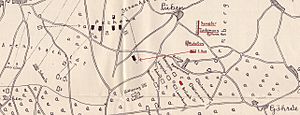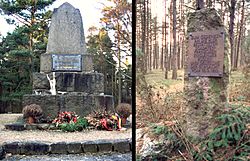Battle of the Göhrde facts for kids
Quick facts for kids Battle of the Göhrde |
|||||||
|---|---|---|---|---|---|---|---|
| Part of the War of the Sixth Coalition | |||||||
|
|||||||
| Belligerents | |||||||
| Commanders and leaders | |||||||
| Strength | |||||||
| 12,200 38 guns |
3,080 6 guns |
||||||
| Casualties and losses | |||||||
| 558-1,100 | 1,500-2,500 6 guns |
||||||
The Battle of the Göhrde was an important fight during the War of the Sixth Coalition. It happened on September 16, 1813, near a place called Göhrde in Germany. In this battle, soldiers from several countries, known as the Coalition, fought against French troops. The Coalition forces won, and the French had to retreat towards Hamburg.
Contents
Where the Battle Happened
The battle took place near what is now the Göhrde State Forest. This area is close to the towns of Dannenberg and Lüneburg. Back then, this land was part of Hanover, which France had taken over in 1803. Today, the battlefield is on the border between the Lüneburg and Lüchow-Dannenberg districts. It lies between Oldendorf an der Göhrde and Göhrde.
How the Battle Started
In March 1813, Russian soldiers pushed the French out of Hamburg and parts of Hanover. Then, Prussia joined the war against France. Many areas in eastern Hanover also rose up against Napoleon's rule.
General Ludwig von Wallmoden-Gimborn took command of all the Allied troops in the Lower Elbe region. His army included soldiers from Prussia, Russia, the United Kingdom, Hanover, Hamburg, Mecklenburg, and Sweden. Groups like the Lützow Free Corps were part of his forces. They often attacked French supply lines.
The French army, led by Marshal Davout, was mostly staying put. But in September, Davout sent General Marc Nicolas Louis Pécheux with about 3,000 soldiers. Pécheux's mission was to stop the attacks and then join other French troops in Magdeburg.
General Wallmoden's army, with about 12,300 men, moved to stop Pécheux. On September 15, they crossed the Elbe River and set up camp in Dannenberg.
The Battle Begins
General Pécheux's French division decided to attack the Allied forces. On the afternoon of September 16, 1813, they reached the Steinker Heights in Nahrendorf and the fighting began.
General Wallmoden's infantry attacked the center of the French line. At the same time, General Dornberg led the King's German Legion (KGL) cavalry and artillery to attack the French left side. At first, their cannon and rocket fire wasn't very effective because they were too far away.
As the French began to pull back, they formed into defensive squares. Then, Lieutenant Thomas Fox Strangways moved the new Congreve Rockets closer to the enemy. The rockets caused great fear among the French soldiers. The 3rd KGL Hussars cavalry broke through two of the French squares. The French lines fell apart, and they fled in all directions.
What Happened After the Battle
The Battle of the Göhrde was a big win for the Allied forces. It was the first time they had defeated French troops in Germany during this part of the war. This victory was very important because it cut off the French army in Hamburg from Napoleon's main army in Saxony. It also blocked French supply routes across Hanover.
This result helped set the stage for the even bigger Battle of Leipzig that happened soon after. The Battle of the Göhrde was also the first time the new Congreve Rockets were used successfully in a battle. These rockets would play an even bigger role later at the Battle of Leipzig.
Remembering the Battle
A large stone monument was built in 1839 to remember the battle. It stands about 2 kilometers north of Bundesstraße 216, near Oldendorf.
About 1,000 soldiers from both sides died in the battle. They were buried together in a mass grave in the forest, about 100 meters from the memorial. This grave was found again in 1985.
A famous freedom fighter named Eleonore Prochaska also fought in this battle. She disguised herself as a man to join the Lützow Free Corps. Sadly, she was wounded during the battle and died from her injuries in a hospital in Dannenberg.
Every two years, people in Dahlenburg recreate the battle to remember it. The local museum there has a special display of the battle, with 1,500 tiny tin soldiers.
Images for kids




